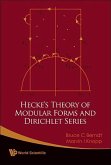Please note that the content of this book primarily consists of articles available from Wikipedia or other free sources online. In mathematics, the Dirichlet eigenvalues are the fundamental modes of vibration of an idealized drum with a given shape. The problem of whether one can hear the shape of a drum is: given the Dirichlet eigenvalues, what features of the shape of the drum can one deduce. Here a "drum" is thought of as an elastic membrane , which is represented as a planar domain whose boundary is fixed.The boundary value problem (1) is, of course, the Dirichlet problem for the Helmholtz equation, and so is known as a Dirichlet eigenvalue for . Dirichlet eigenvalues are contrasted with Neumann eigenvalues: eigenvalues for the corresponding Neumann problem. The Laplace operator appearing in (1) is often known as the Dirichlet Laplacian when it is considered as accepting only functions u satisfying the Dirichlet boundary condition. More generally, in spectral geometry one considers (1) on a manifold with boundary . Then is taken to be the Laplace-Beltrami operator, also with Dirichlet boundary conditions.
Bitte wählen Sie Ihr Anliegen aus.
Rechnungen
Retourenschein anfordern
Bestellstatus
Storno








